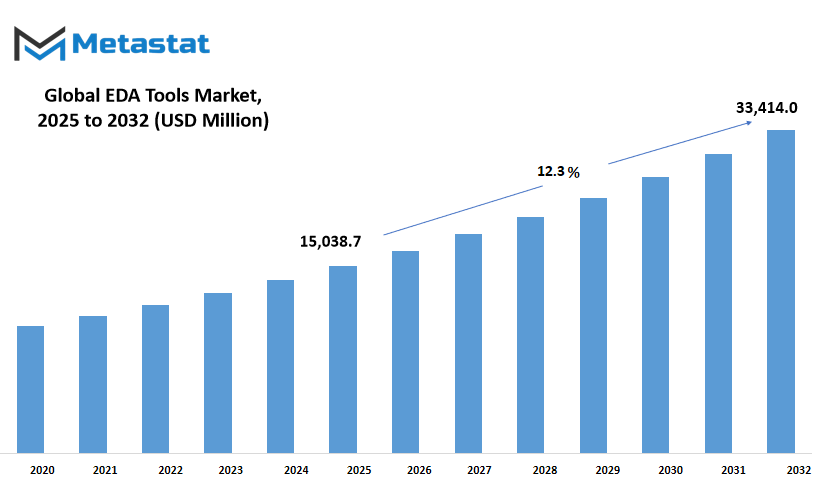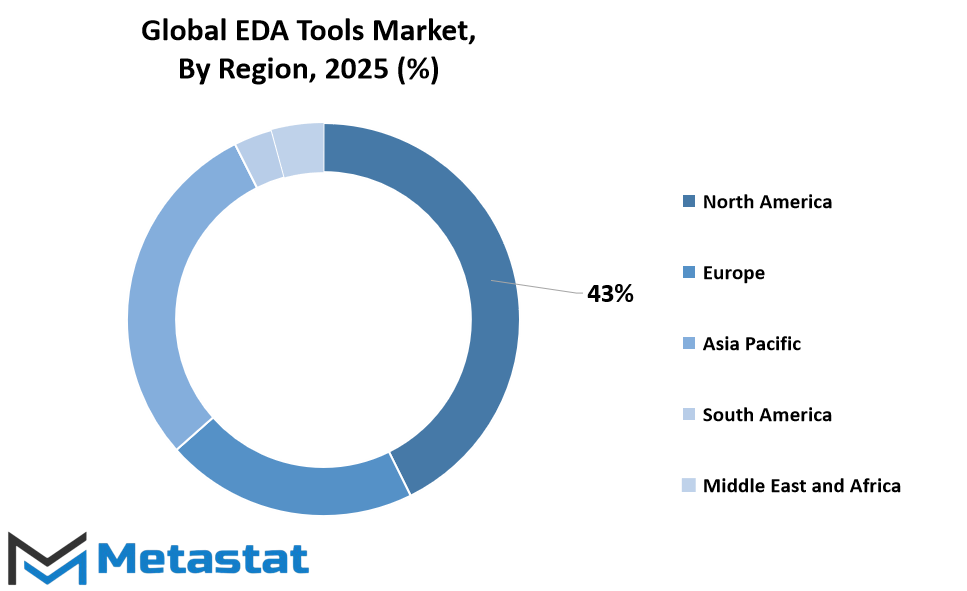MARKET OVERVIEW
The global EDA tools market is a niche group of the broader electronic design automation sector, primarily dealing with software-based solutions applied to electronic system and integrated circuit designing and verification. This market exists for the purpose of assisting engineers and businesses engaged in the design of semiconductors, printed circuit boards, and other types of electronic hardware. Its importance is driven by the escalating complexity of contemporary electronic equipment, which will further require advanced tools to facilitate design, simulation, and verification processes.
Fundamentally, the global EDA tools market will be the foundation for firms that develop in electronics. Whether designing the next generation of smartphones or honing sophisticated automotive electronics, firms will rely on EDA software to attain accuracy and efficiency. The software in this market will enable schematic capture, layout design, behavioral modeling, and hardware description language simulation. These features guarantee that the designs will be working properly before they proceed to expensive fabrication steps.
What will differentiate this market will be its focus on meeting future needs. As semiconductor nodes become smaller and devices demand greater functionality in smaller spaces, the global EDA tools market will be required to provide tools that can manage such high levels of complexity without compromising on performance or accuracy. The software tools being offered will not only facilitate design capabilities but also include features that enable engineers to predict and prevent possible failures, making the product reliable for use in the real world.
In addition to this, this market will go beyond fundamental design software. It will involve tools that are customized for specific requirements, including analog, digital, mixed-signal, and radio frequency design domains. The global EDA tools market will also involve products that serve upcoming sectors like photonic design and quantum computing structures. Although these spaces will appear niche presently, they will be major areas for EDA solutions as technology topologies change.
The competitive dynamics in this market will propel ongoing improvements in functionality. Major software vendors will spend heavily on R&D, focused on providing solutions that provide seamless interoperability with other engineering environments. This feature will be extremely important as firms will more and more need streamlined workflows that minimize time-to-market and improve collaboration among geographically distributed teams. Integration of artificial intelligence and machine learning into these tools will also redefine how designers solve problems, with software able to provide recommendations for optimizations or identify design risk in real-time.
Moreover, the global EDA tools market will have a ripple effect on the overall direction of the semiconductor industry. With the fast-growing pace of technology innovation, such tools will not only be required for design but for winning competitive edges too. Firms that cannot take advantage of the latest EDA tools might find it difficult to match the pressures for greater efficiency and reduced product cycles. Therefore, the industry will have a strategic influence on future evolution in many industries linked to electronics production.
The global EDA tools market will ultimately serve as a facilitator of advancement in technology-based industries. Though the tools themselves will become increasingly advanced, their function will remain focused on providing the basis on which electronic innovations of the future are constructed. This consistent requirement will make the need for such solutions continue, and therefore place the market firmly at the center of technology development in the future.
Global EDA tools market is estimated to reach $33,414.0 Million by 2032; growing at a CAGR of 12.3% from 2025 to 2032.

GROWTH FACTORS
The global EDA tools market will continue to play an important role in shaping the future of the electronics industry. EDA tools, also known as Electronic Design Automation tools, are used to design and create electronic systems such as microchips and circuit boards. As technology keeps advancing, these tools will remain highly important because they help companies produce smaller, faster, and more efficient electronic products. The demand for consumer electronics, electric vehicles, and smart devices is expected to rise further, which will push the need for more advanced EDA tools. This demand will be a major factor driving the global EDA tools market in the coming years.
Another key driving factor for the global EDA tools market is the growing use of artificial intelligence and machine learning. These technologies are being integrated into EDA tools to make the design process smarter and faster. AI helps detect potential errors early in the design phase, which saves time and cost. As companies try to bring their products to market more quickly, tools that improve efficiency and accuracy will be in high demand. This trend will encourage more businesses to invest in better and smarter EDA tools.
However, there are certain challenges that might hamper the market growth. One of these challenges is the high cost of EDA tools. Many smaller companies or startups may not be able to afford the latest software, which could slow down their progress. Additionally, the complexity of these tools requires skilled professionals to operate them. The shortage of experienced engineers in this field might also act as a barrier to growth.
On the other hand, the rise of new technologies and the growing interest in fields like quantum computing and 5G will provide lucrative opportunities for the global EDA tools market. As new types of electronic products are developed, the need for more advanced and specialized EDA tools will increase. Companies that focus on creating tools to support these technologies will likely see strong growth and new business opportunities in the future.
Looking ahead, the global EDA tools market will likely continue to expand as electronics become even more essential to daily life. Innovations in technology will push the boundaries of what EDA tools can do, making them more powerful and more widely used. While some obstacles might slow the pace, the overall outlook remains positive, and the market will see new possibilities as industries evolve and new demands appear.
MARKET SEGMENTATION
By Type
The global EDA tools market is expected to continue growing as technology keeps advancing and industries rely more heavily on electronic design automation tools. These tools play a key role in the design and development of electronic systems and products. They help engineers and designers create more complex and accurate systems in a shorter time, which leads to faster innovation and reduced costs. As we look ahead, it is clear that demand for these tools will not slow down but will continue to rise as new challenges and opportunities emerge in technology.
Looking at the future of the global EDA tools market, it is important to understand how different types contribute to this progress. Computer-aided Engineering (CAE) will keep helping designers simulate and test products before they are even built. This reduces the risk of failure and allows for more creative solutions without the cost of physical prototypes. CAE tools will likely become smarter and more automated, predicting issues before they happen and offering solutions in real-time.
IC Physical Design and Verification is another important area. As microchips get smaller and more powerful, the need for precise design tools becomes even more critical. In the future, these tools will be expected to handle more data, work faster, and offer better accuracy. They will need to support new manufacturing techniques and materials that are being developed to meet the growing need for performance and energy efficiency.
Printed Circuit Board and Multi-chip Module (PCB and MCM) tools will also see advancements. These are essential for connecting components in electronic devices. Future tools in this category will likely offer more detailed analysis and testing features, making sure that products work as expected under different conditions. With the rise of AI, these tools may even suggest improved layouts and connections automatically.
Semiconductor Intellectual Property (SIP) plays a large role too. Companies reuse proven designs to save time and reduce costs, and this practice will only become more common. SIP tools will evolve to make it easier to integrate these designs into new products and to protect ownership rights more effectively.
Finally, services related to EDA tools will continue to grow in importance. As tools become more advanced, companies will need expert support to get the most out of them. Training, updates, and troubleshooting will be key parts of this. The global EDA tools market is shaping a future where technology and human creativity come together to build better solutions faster than ever before.
By Application
The global EDA tools market is expected to see steady growth in the years ahead as technology continues to shape how industries operate. EDA, which stands for Electronic Design Automation, plays a crucial role in helping companies design and develop complex electronic systems and components. As demand rises for more advanced technologies, this market will naturally expand to support the needs of businesses across various sectors.
One of the most important applications of these tools is in the Aerospace & Defense sector. Companies in this field rely on accurate and efficient design tools to create systems that must meet the highest standards of performance and safety. With advancements in areas like satellite communications, defense systems, and aviation technology, the need for reliable design solutions will continue to grow. EDA tools make it easier for engineers to create detailed models and simulations, allowing them to test designs thoroughly before moving to production. This saves time and reduces costs while also improving the overall quality of the final product.
In the Electronics & Manufacturing sector, the global EDA tools market will play a major part in driving innovation. As electronic devices become smaller, faster, and more powerful, companies will need advanced tools to keep up with these trends. From consumer gadgets to industrial equipment, precise and efficient design processes will be key to staying competitive. These tools help streamline workflows and allow designers to bring products to market faster without sacrificing quality.
Telecom is another field where these tools have become essential. With the rapid expansion of 5G and the continued growth of internet infrastructure, telecom companies will require reliable solutions to develop the technology that keeps people connected. EDA tools support the creation of everything from network hardware to mobile devices, ensuring that systems perform well under increasing demands.
In the Medical field, the global EDA tools market supports the development of critical devices that help improve patient care. From diagnostic machines to wearable health monitors, precision is vital. These tools assist in the design of electronics that must work flawlessly, often under strict regulatory guidelines. As healthcare technology advances, demand for these tools will rise alongside it.
Finally, there are other areas where these tools are making a difference. Whether it's in automotive electronics, renewable energy, or education, the potential applications continue to grow. Looking ahead, the global EDA tools market will remain a key part of technological progress, helping industries bring their ideas to life more efficiently and effectively.
|
Forecast Period |
2025-2032 |
|
Market Size in 2025 |
$15038.7 million |
|
Market Size by 2032 |
$33414.0 Million |
|
Growth Rate from 2025 to 2032 |
12.3% |
|
Base Year |
2024 |
|
Regions Covered |
North America, Europe, Asia-Pacific Green, South America, Middle East & Africa |
REGIONAL ANALYSIS
The global EDA tools market is expected to experience noticeable growth in the coming years, driven by technological advancements and increasing demand for more efficient design solutions. Electronic Design Automation (EDA) tools are essential in the development of modern electronic systems. These tools help designers create, verify, and analyze the complex designs used in semiconductors, integrated circuits, and printed circuit boards. As industries continue to push the boundaries of technology, the need for these tools will only become more significant.
Geographically, the global EDA tools market is divided into several regions, each contributing differently to its growth. North America, with the United States, Canada, and Mexico, plays a major role due to the strong presence of key technology companies and advanced research facilities. The U.S., in particular, leads in innovations that shape the future of electronic design. Europe, which includes the UK, Germany, France, Italy, and other countries, also holds a considerable share of the market. Countries like Germany and France are home to many established technology firms that continue to invest in research and development. These investments are expected to drive further advancements and fuel market demand.
Asia-Pacific is another crucial region for the global EDA tools market. Countries such as China, India, Japan, and South Korea are making significant strides in technology. These nations are not only expanding their manufacturing capabilities but are also focusing on developing their own technological solutions. Governments in this region are encouraging innovation through policies and funding, which will likely result in greater adoption of EDA tools in the future. As these markets mature, they will present even more opportunities for growth and partnerships.
South America, including Brazil and Argentina, shows potential for future expansion, although at a slower pace compared to other regions. As these countries continue to improve their technological infrastructure, they are likely to embrace EDA tools more widely. Meanwhile, the Middle East and Africa, covering areas such as GCC Countries, Egypt, and South Africa, is gradually catching up. Increased investment in technology and infrastructure will help these regions become more active participants in the global EDA tools market.
Looking ahead, this market will continue to grow as the world moves towards smarter and more connected devices. Companies across all these regions will rely on EDA tools to stay competitive and meet the demands of future technologies. As industries adopt artificial intelligence, machine learning, and automation, the importance of accurate and efficient design tools will only increase.

COMPETITIVE PLAYERS
The global EDA tools market is set to grow steadily as technology continues to push boundaries in design and manufacturing. EDA, or electronic design automation, plays a key role in how engineers and companies develop modern electronics. From chips in mobile phones to systems used in industrial machines, EDA tools help design and test these components before they’re built. As demand increases for smarter, smaller, and more efficient devices, the role of these tools becomes even more important
What’s driving this market forward is not just the need for speed and precision, but the competition among the companies leading this space. Well-known names like Synopsys, Inc. and Cadence Design Systems, Inc. have been shaping the direction of this industry for years. They continue to introduce better software that simplifies complex design work while improving performance. Alongside them, Siemens AG and Zuken Inc. are also playing a strong part by offering advanced solutions that meet growing customer needs
Companies like Empyrean Technology Co., Ltd and CellixSoft Corporation, though not as globally recognized yet, are starting to make noticeable progress. Their focus on innovation allows them to challenge bigger firms and keep the market active. Keysight Technologies and Altium Limited are also expanding their presence by providing tools that help speed up development without sacrificing quality. Their strength lies in making the process easier and more accurate, which appeals to both small businesses and large corporations.
Primarius Technologies and Aldec, Inc. add further depth to this space, bringing in specialized tools that help engineers solve problems faster. These players are essential to the future of the global EDA tools market, not just because of what they offer today, but because of what they are working on for tomorrow. Whether it’s support for new chip designs, improvements in simulation, or easier integration with other platforms, their work will shape how design is done in the future.
As devices become more connected and smarter, the need for better design tools will rise. This will encourage competition and push companies to offer more accurate, efficient, and accessible software. With more industries relying on electronic systems, the global EDA tools market will remain a key part of that progress. The companies leading this market are not only changing how electronics are designed but also how quickly they can reach the people who need them.
EDA Tools Market Key Segments:
By Type
- Computer-aided Engineering (CAE)
- IC Physical Design and Verification
- Printed Circuit Board and Multi-chip Module (PCB and MCM)
- Semiconductor Intellectual Property (SIP)
- Services
By Application
- Aerospace & Defense
- Electronics & Manufacturing
- Telecom
- Medical
- Others
Key Global EDA Tools Industry Players
- Synopsys, Inc.
- Cadence Design Systems, Inc.
- Zuken Inc.
- Empyrean Technology Co., Ltd
- Siemens AG
- CellixSoft Corporation
- Primarius Technologies
- Keysight Technologies
- Altium Limited
- Aldec, Inc.
WHAT REPORT PROVIDES
- Full in-depth analysis of the parent Industry
- Important changes in market and its dynamics
- Segmentation details of the market
- Former, on-going, and projected market analysis in terms of volume and value
- Assessment of niche industry developments
- Market share analysis
- Key strategies of major players
- Emerging segments and regional growth potential








 US: +1 3023308252
US: +1 3023308252






